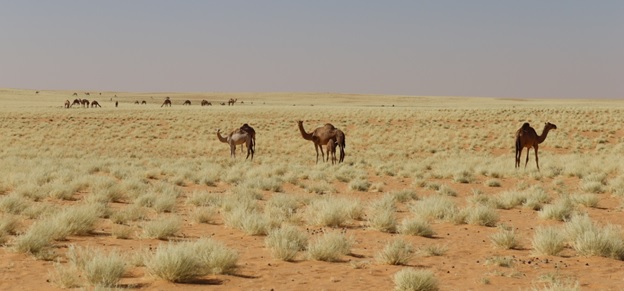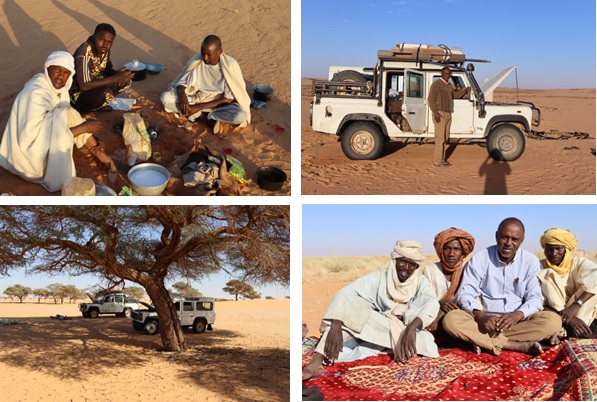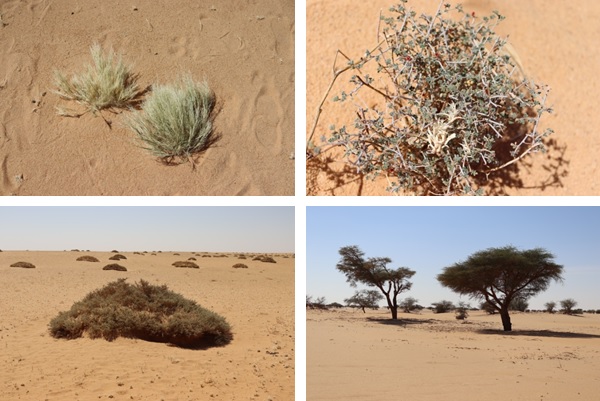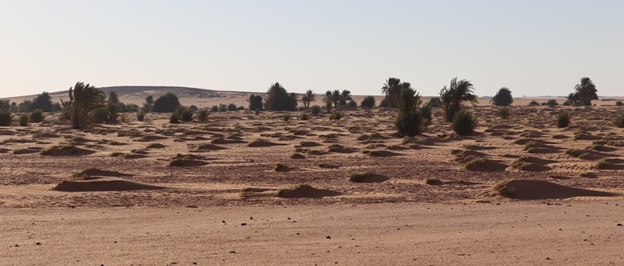Visiting a Unique Pastoral System in the Sahara Desert: the Gizu

By: Hussein Sulieman, Director of Center for Remote Sensing and GIS, University of Gadarif, Sudan and Visiting Fellow at Feinstein International Center, Tufts University
What is the gizu?
The gizu is both a region in the north of western Sudan, and also a Sudanese term for a remarkable form of short-lived vegetation that appears seasonally at irregular intervals. Because the gizu vegetation has high moisture content, livestock eating it do not need water throughout their stay. In Sudan, the gizu is found in northern dry areas of North Kordofan and North Darfur states, where vegetation generally appears in and persists in the dry months from October to March. Traditionally, camel and sheep herders from Darfur and Kordofan use the Sudanese gizu. Recently, goat herders are also using the gizu, however camels remain the predominant species.
The significance of the gizu
Visiting the gizu is a long established practice and it generates significant benefits to the livestock, livelihoods, and wider economy of Sudan. It is an indispensable resource for a significant number of pastoralists for many reasons. The gizu:
- Provides highly nutritious pasture so animals’ nutritional status improves and they fatten quickly after the dry season.
- Provides ideal reproductive conditions that lead to early puberty and high birthing rates.
- Animals stay healthy, and disease is lessened.
- Minimizes the expense of watering and buying of salts for animals.
- Contributes to the peace and security of the region, including the northern territories, the central and southern cultivation zones, and the dry season grazing areas by regulating the southward mobility of pastoralists during the sensitive harvest period.
The study of the gizu
This study aims to record the unique resilience and potential of the gizu pastoralist system, including its scientific rationale and social interconnections and institutions, to promote sustainable livelihoods and peaceful relations and security throughout the Darfur region. We will do this by:
- Analyzing the geographical extent, seasonal dynamics, and main climatic factors affecting the gizu and the implications of the gizu on livestock performance and productivity
- identifying and documenting the strategies that pastoralists from different ethnic groups use to access the gizu and the roles played by customary institutions
- exploring the implications of conflict and insecurity on livestock as they move to the gizu and the ways pastoralists cope with conflict during their annual migrations
- identifying key stakeholder groups, their interests, experience, and knowledge gaps to design targeted research outputs/infographics to meet their needs.
The visit to the gizu
The research team covered about 1,500 km on its visit to the gizu area of North Darfur from 11 to 19 November 2021. The visit aimed to gather information from pastoralists visiting the gizu about their experiences, patterns of livestock mobility to and from and within the gizu, and plant species of the gizu. The team also collected coordinates of important features across the gizu and photographed the different types of landscapes of the gizu and pastoralists practices.

The team of the field study visit to the Gizu
The gizu of 2021
There was no new gizu growth in 2021 due to the lack of rains at the end of September and throughout October 2021. One could travel for hours without seeing a tree or shrub. However, in valleys such as Wadi Howar and Wadi Majror and oases such as Bir Atrun, we saw scattered trees and small pockets of light to dense tree and shrub covers. We also saw pockets of vegetation cover that was leftover from 2020’s growth in the undulated sand dunes (the dominant soil type in the area). These pockets ranged from a couple of square kilometers to as far as the eye could see. Overall, we recorded 17 species of herbs and grasses and 8 species of trees and shrubs. The photos below give examples from selected areas. The last time that the quality of the gizu was so poor was 2016/2017.

Examples of herbaceous plants, trees, and shrubs found in November 2021 in the gizu
Finding pastoralists in the gizu
It was challenging to find pastoralists in a non-gizu year because fewer pastoralists come to the area when the gizu is poor. Those who do come are scattered among the small pockets of vegetation cover remaining from last year, which are difficult to find. Knowing that we would face this challenge, we worked with our contacts to find out the approximate location of a couple of camel herds before we set out. Our journey began from El Fasher, the capital of North Darfur. From there it took us two days to reach the gizu and locate the camel herd we were looking for. This first group then gave us the location of other groups and we continued to work in this way to meet a total of nine groups of herders over 10 days.
How the 2021 gizu compares to previous years
Prior to 2021, the gizu had four good seasons in a row. The pastoralists we met were frustrated by the lack of gizu this year. They arrived almost one month later than their usual time, which is the beginning of October. They delayed their arrival so that they could first use the vegetation from the rainy season outside the area and preserve the gizu resources for later in the dry season. Once they arrived, they had to scout extensively to find the small vegetation patches.
After arriving in the gizu this year, pastoralists’ movement has been restricted to areas where pasture are available. In a normal gizu year, this is not an issue for pastoralists because fodder is widely available and animals totally rely on the moisture content of the gizu succulent plants for three months or longer, depending on when the vegetation begins to dry. This year, pastoralists have to regularly trek the camels to a water facility because the plants’ moisture content is too low. Those with sheep have to remain close (within 2 – 3 days walk) to water sources. In the last four years, some sheep herders have begun to extend their stay in the gizu for the whole year. After the vegetation dries, they rely on plastic water bladders to water their flocks and for their families’ domestic needs.
Despite the poor gizu vegetation this year, pastoralists told us that the nutritional value of the gizu is still better than that of the plants that grow on the range outside of the gizu area.
Recent changes to the gizu
Historically, the remote gizu is rarely visited by people other than herders. However, in the last two decades, as trucks have become more available and migration and trade between Libya and Sudan more common, more non-herders are passing through the gizu. During this same period, pastoralists have started seeing increased traffic and technology, such as:
- The emergence of artisan gold mining
- Flourishing trade and traffic between Sudan and Libya
- Increased use of vehicles, tankers, and water bladders, that support pastoralism
- New investment by the private sector in water facilities
- The appearance of armed movements and rapid support forces
- Use of mobile and Thuraya phone and GPS facility in smart mobiles
Along with the increased traffic and technology in the gizu, other more radical changes include:
- Traders using large trucks to transport small vehicles into Sudan are purchasing sheep in the gizu to trade in Libya. This started around 2014 and has offered pastoralists good opportunities to locally sell their animals, which is better than trekking or transporting them for hundreds of kilometers to the weekly markets outside of the gizu.
- A small number of pastoralists in the gizu have diversified their livelihoods to include activities such as artisan gold mining and livestock and goods trading. These activities began around 2012.
- Some pastoralists have purchased vehicles to transport their families and small animals and for scouting.
- Some livestock owners are now hiring herders to take their herds to the gizu while they remain in urban centers, where they can enjoy the urban conveniences.
About the project
The Gizu Study is led by Hussein Sulieman, Professor and Director of Center for Remote Sensing and GIS, University of Gadarif, Sudan and Visiting Fellow at Feinstein International Center, Tufts University, and supported by a team from the Feinstein International Center at Tufts University led by Helen Young, Professor and Research Director.

Naturally regenerated date palm trees in Bir Atrun Oasis
